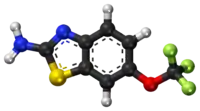Riluzole
Riluzole is a medication used to treat amyotrophic lateral sclerosis and other motor neuron diseases. Riluzole delays the onset of ventilator-dependence or tracheostomy in some people and may increase survival by two to three months.[2] Riluzole is available in tablet and liquid form.
 | |
 | |
| Clinical data | |
|---|---|
| Trade names | Rilutek, Tiglutik, Exservan, others |
| AHFS/Drugs.com | Monograph |
| MedlinePlus | a696013 |
| License data | |
| Pregnancy category |
|
| Routes of administration | By mouth |
| ATC code | |
| Legal status | |
| Legal status | |
| Pharmacokinetic data | |
| Bioavailability | 60±18%[1] |
| Protein binding | 97%[1] |
| Metabolism | Hepatic (CYP1A2)[1] |
| Elimination half-life | 9–15 hours[1] |
| Excretion | Urine (90%)[1] |
| Identifiers | |
IUPAC name
| |
| CAS Number | |
| PubChem CID | |
| IUPHAR/BPS | |
| DrugBank | |
| ChemSpider | |
| UNII | |
| KEGG | |
| ChEMBL | |
| CompTox Dashboard (EPA) | |
| ECHA InfoCard | 100.124.754 |
| Chemical and physical data | |
| Formula | C8H5F3N2OS |
| Molar mass | 234.20 g·mol−1 |
| 3D model (JSmol) | |
SMILES
| |
InChI
| |
| (verify) | |
Medical use
Amyotrophic lateral sclerosis
Riluzole was approved in the United States for the treatment of ALS by the U.S. Food and Drug Administration (FDA) in 1995.[3] A Cochrane Library review states a 9% gain in the probability of surviving one year.[2]
Adverse effects
- Very common (>10% frequency):[4] nausea; weakness; decreased lung function
- Common (1–10% frequency):[5] headache; dizziness; drowsiness; vomiting; abdominal pain; increased aminotransferases
- Uncommon (0.1-1% frequency):[5] pancreatitis; interstitial lung disease
- Rare (<0.1% frequency):[5] neutropenia; allergic reaction (including angiooedema, anaphylactoid reaction)
Overdose
Symptoms of overdose include: neurological and psychiatric symptoms, acute toxic encephalopathy with stupor, coma and methemoglobinemia.[1] Severe methemoglobinemia may be rapidly reversible after treatment with methylene blue.[1]
Contraindications
Contraindications for riluzole include: known prior hypersensitivity to riluzole or any of the excipients inside the preparations, liver disease, pregnancy or lactation.[1]
Mechanism of action
Riluzole preferentially blocks TTX-sensitive sodium channels, which are associated with damaged neurons.[6][7] Riluzole has also been reported to directly inhibit the kainate and NMDA receptors.[8] The drug has also been shown to postsynaptically potentiate GABAA receptors via an allosteric binding site.[9] However, the action of riluzole on glutamate receptors has been controversial, as no binding of the drug to any known sites has been shown for them.[10][11] In addition, as its antiglutamatergic action is still detectable in the presence of sodium channel blockers, it is also uncertain whether or not it acts via this way. Rather, its ability to stimulate glutamate uptake seems to mediate many of its effects.[12][13] In addition to its role in accelerating glutamate clearance from the synapse, riluzole may also prevent glutamate release from presynaptic terminals.[14] Since CK1δ plays a key role in TDP-43 proteinopathy, a pathological hallmark of ALS, this could help to better decipher drug mechanism of action.
Synthesis
Riluzole can be prepared beginning with the reaction of 4-(trifluoromethoxy)aniline with potassium thiocyanate followed by reaction with bromine, forming the thiazole ring.[15][16][17]
 Riluzole synthesis
Riluzole synthesis
Society and culture
Legal status
Riluzole was approved for medical use in the European Union in October 1996.[18]
Research
A number of case studies have indicated that riluzole may have use in mood and anxiety disorders.[19]
A reformulation of riluzole that originated at Yale University and is known by the code name BHV-0223[20] is under development for the treatment of generalized anxiety disorder and mood disorders by Biohaven Pharmaceuticals.[21]
Riluzole, which is neuroprotective and a glutamate modulator could be used for psychiatric problems though it failed in trials of Huntington's disease and Parkinson's disease.[22]
See also
References
- "PRODUCT INFORMATION RILUTEK® (riluzole) Tablets" (PDF). TGA eBusiness Services. sanofi-aventis australia pty ltd. January 6, 2009. Retrieved February 18, 2014.
- Miller, RG; Mitchell, JD; Moore, DH (March 14, 2012). "Riluzole for amyotrophic lateral sclerosis (ALS)/motor neuron disease (MND)". The Cochrane Database of Systematic Reviews. 3 (3): CD001447. doi:10.1002/14651858.CD001447.pub3. PMC 7055506. PMID 22419278.
- "Riluzole".
- "Rilutek (riluzole) dosing, indications, interactions, adverse effects, and more". Medscape Reference. WebMD. Retrieved February 18, 2014.
- Rossi, S, ed. (2013). Australian Medicines Handbook (2013 ed.). Adelaide: The Australian Medicines Handbook Unit Trust. ISBN 978-0-9805790-9-3.
- Song, JH; Huang, CS; Nagata, K; Yeh, JZ; Narahashi, T (August 1997). "Differential action of riluzole on tetrodotoxin-sensitive and tetrodotoxin-resistant sodium channels" (PDF). The Journal of Pharmacology and Experimental Therapeutics. 282 (2): 707–14. PMID 9262334.
- Bellingham, MC (February 2011). "A review of the neural mechanisms of action and clinical efficiency of riluzole in treating amyotrophic lateral sclerosis: what have we learned in the last decade?". CNS Neuroscience & Therapeutics. 17 (1): 4–31. doi:10.1111/j.1755-5949.2009.00116.x. PMC 6493865. PMID 20236142.
- Debono MW, Le Guern J, Canton T, Doble A, Pradier L (April 1993). "Inhibition by riluzole of electrophysiological responses mediated by rat kainate and NMDA receptors expressed in Xenopus oocytes". Eur. J. Pharmacol. 235 (2–3): 283–9. doi:10.1016/0014-2999(93)90147-a. PMID 7685290.
- He, Y.; Benz, A.; Fu, T.; Wang, M.; Covey, D.F.; Zorumski, C.F.; Mennerick, S. (2002). "Neuroprotective agent riluzole potentiates postsynaptic GABAA receptor function". Neuropharmacology. 42 (2): 199–209. doi:10.1016/s0028-3908(01)00175-7. PMID 11804616. S2CID 24194421.
- Wokke, J (September 21, 1996). "Riluzole". Lancet. 348 (9030): 795–9. doi:10.1016/S0140-6736(96)03181-9. PMID 8813989. S2CID 208788906.
- Kretschmer BD, Kratzer U, Schmidt WJ (August 1998). "Riluzole, a glutamate release inhibitor, and motor behavior". Naunyn Schmiedebergs Arch. Pharmacol. 358 (2): 181–90. doi:10.1007/pl00005241. PMID 9750003. S2CID 5887788.
- Azbill, RD; Mu, X; Springer, JE (July 2000). "Riluzole increases high-affinity glutamate uptake in rat spinal cord synaptosomes". Brain Res. 871 (2): 175–80. doi:10.1016/S0006-8993(00)02430-6. PMID 10899284. S2CID 23849619.
- Dunlop, J; Beal McIlvain, H; She, Y; Howland, DS (March 1, 2003). "Impaired spinal cord glutamate transport capacity and reduced sensitivity to riluzole in a transgenic superoxide dismutase mutant rat model of amyotrophic lateral sclerosis". J. Neurosci. 23 (5): 1688–96. doi:10.1523/JNEUROSCI.23-05-01688.2003. PMC 6741992. PMID 12629173.
- Wang, S.-J (January 2004). "Mechanisms underlying the riluzole inhibition of glutamate release from rat cerebral cortex nerve terminals (synaptosomes)". Neuroscience. 125 (1): 191–201. doi:10.1016/j.neuroscience.2004.01.019. PMID 15051158. S2CID 35667296.
- L. M. Yagupol'skii, L. Z. Gandel'sman, Zh. Obshch. Khim. 33, 2301 (1963), C.A. 60, 692a (1964).
- EP 50551, Mizoule, Jacques, "Medicament containing 2-amino-6-trifluoro-methoxy benzothiazole", published 1982-04-28, assigned to Pharmindustrie; J. Mizoule, U.S. Patent 4,370,338 (1983 to Pharmindustrie).
- U.S. Patent 4,826,860
- "Rilutek EPAR". European Medicines Agency (EMA). Retrieved October 1, 2020.
- Grant, P; Song, JY; Swedo, SE (2010). "Review of the use of the glutamate antagonist riluzole in psychiatric disorders and a description of recent use in childhood obsessive-compulsive disorder". J Child Adolesc Psychopharmacol. 20 (4): 309–15. doi:10.1089/cap.2010.0009. PMC 2958461. PMID 20807069.
- "BHV 0223 – AdisInsight". Adisinsight.springer.com. Retrieved May 20, 2016.
- Harris, Elaine (2015). "Industry update: the latest developments in therapeutic delivery". Therapeutic Delivery. 6 (6): 647–652. doi:10.4155/tde.15.44. ISSN 2041-5990.
- Zarate CA, Manji HK (September 2008). "Riluzole in psychiatry: a systematic review of the literature". Expert Opin Drug Metab Toxicol. 4 (9): 1223–34. doi:10.1517/17425255.4.9.1223. PMC 2587133. PMID 18721116.
External links
- National Institute for Health and Clinical Excellence (NICE) guidelines for prescription of riluzole in the UK
- "Riluzole". Drug Information Portal. U.S. National Library of Medicine.